服务战略案例
【原创】增值服务如何做?(案例两则)

【原创】增值服务如何做?(案例两则)差异化看起来很美,做起来很难!差异化的服务需要精心设计,增值服务及增值战略其实不难理解,关键是高层参与,本文将与您分享全球两则典型的工业品销售及增值服务案例。
案例一:欧洲British Sugar公司糖是世界上最为常见的日用品之一,长期以来,许多企业都没能成功地把它们的糖类制品与竞争者的产品保持差异化。
英国的British Sugar公司没使多大劲就把他们的糖类制品与别人的糖类制品形成了差异。
它们没把焦点放在产品上,而是注意力集中到了企业本身所能提供的价值上面——增值战略。
British Sugar公司的增值战略主要建立在以下2个关键增值手段之上:1、有效利用咨询技能第一个战略性的增值手段是,公司有效利用在环保方面的咨询技能——这种技能其实早就已经在公司内部形成并一直在公司内部被运用。
British Sugar的许多客户都属于食品行业,它们和British Sugar 一样一直为处理糖和其他食品加工过程中所产生的废物问题而感到困惑。
作为战略的一部分,British Sugar挑选出了六家具有战略意义的客户,并免费为它们提供环保方面的技术,这六家客户都接受了British Sugar的环保技术。
从第一天起,这六家客户就显著地降低了他们的运营成本。
有几家客户再也不用为这方面的咨询工作而额外付费了,而另外几家客户则最终无需再在公司里保留环保部。
2、出售过剩能力第二个手段是向这六家客户出售本公司过剩的电力。
电力是British Sugar的主要成本(20/80性质的成本),几年前,当英国开始对电力解禁的时候(就像美国现在所做的一样),British Sugar就购并了一家发电厂来专门为自己发电。
后来,British Sugar发现发电厂所发的电超过了自己的需求,如何处理这些过剩的电力呢?公司管理层没有把这些过剩的电力出售以获取利润,而是把它以成本价提供给这六家战略性客户――不多收一分钱(British Sugar提供给客户的电力价格比业内的最低批发价低70%)。
技术领先战略案例

技术领先战略案例技术领先战略案例:1. Apple的iOS操作系统:苹果公司将iOS操作系统作为其技术领先战略的核心,通过不断的创新和改进,提供稳定、安全、易用的操作系统,为其iPhone和iPad产品赢得了市场份额的领先地位。
2. Tesla的电动汽车技术:特斯拉公司通过研发先进的电动汽车技术,包括高性能电池、电动驱动系统和自动驾驶技术,实现了电动汽车市场的领导地位,并推动了整个汽车行业的转型。
3. Amazon的云计算服务:亚马逊公司通过开发先进的云计算平台Amazon Web Services(AWS),为企业提供灵活、高效、安全的云计算服务,成为全球领先的云计算提供商。
4. Google的搜索引擎算法:谷歌公司通过不断优化其搜索引擎算法,提供更准确、更相关的搜索结果,成为全球最受欢迎的搜索引擎,并以此为基础构建了其广告业务和其他技术服务。
5. Microsoft的Windows操作系统:微软公司通过持续的研发和改进,将Windows操作系统打造成全球最流行的个人电脑操作系统,为其办公软件和其他产品提供了强大的支持。
6. IBM的人工智能技术:IBM公司通过研发先进的人工智能技术,如深度学习和自然语言处理,为企业提供智能化的解决方案,提高了工作效率和决策能力。
7. Intel的芯片制造技术:英特尔公司通过不断创新和投资研发,推动了芯片制造技术的发展,为计算机和其他电子产品提供高性能、低功耗的处理器,保持了市场的领先地位。
8. Samsung的显示技术:三星公司通过持续的研发和创新,成为全球领先的显示技术提供商,包括液晶显示器、OLED显示器和曲面显示器等,为电视、手机和其他电子产品提供了卓越的显示效果。
9. NVIDIA的图形处理器:英伟达公司通过其先进的图形处理器(GPU)技术,为游戏、人工智能和科学计算等领域提供了强大的计算能力,成为全球领先的GPU供应商。
10. Huawei的5G技术:华为公司通过自主研发和持续投资,成为全球领先的5G技术提供商,为全球通信行业的发展做出了重要贡献,推动了物联网和智能城市等领域的发展。
战略管理案例--新加坡航空公司如何保持优质服务

新加坡航空公司如何保持优质服务目前,我国服务业在GDP中所占比重不到40%,而在美国高达80%,在印度也高达50%,真正的机会在服务业,未来的发展也在服务业。
那么,作为服务业中的重要组成部分,物业管理与物业服务应该朝着怎样的方向发展?怎样做才能够快速提升这个行业的经营水平和含金量?我们需要做出哪些切实的努力才能逐步达成目标?我想,我们可以从世界公认的一流服务公司——新加坡航空公司中寻找借鉴。
观念与态度决定了一切新航的服务理念是“任何事都要做到最好”,这是一种姿态,也是一种要求。
有“做到最好”的观念、有“做到最好”的态度,才有“做到最好”的可能。
这种高要求和高期望意味着我们必须要不断的评价和改进自身的服务,所以,我们必须要树立一种系统的理念:服务自评。
新航的管理层致力于客户服务的提升,建立了以客户为核心的员工团队和公司体系,以及以客户为导向的企业文化。
新航一直在普及一种认知:“我要用最好的服务来代替现有的服务”。
我们必须让每一个员工形成一种思考习惯:现在的服务状态是怎样的?好评度达到多少?主要的缺陷在哪里?这种思考习惯的形成是发现问题、分析问题的过程,也是解决问题的前提。
那么,怎样让员工形成这种思考习惯呢?这就需要管理人员不断的提醒、不断的灌输。
服务比较。
新航内部有着非常成熟的比较体制,在企业内部寻找榜样,评选服务模范。
在行业内部寻找借鉴,学习他人所长。
新航还经常派出“体验团队”乘坐竞争对手的航班,体验服务差距,然后寻找改善的突破口,实现自身的提升。
标准化服务和个性化服务的平衡。
新航有一张很长的列表,上面是乘客对优质服务所有的期望,包括功能、技术、态度等多方面的标准。
标准化服务就是强调服务的一致性——不因为客户的不同而改变服务质量,不因为员工的不同而影响服务效果。
这就需要将服务的类别、标准细化到可以量化评价的程度,从而建立统一的服务水准。
在此基础上更高层的因素是软性技术,比如:热情、关心和对客户差异性需求的满足,这就需要建立灵活、生动、人性化的理念。
华为以客户为中心的案例

华为以客户为中心的案例在当今商业竞争激烈的环境中,以客户为中心的战略已经成为企业取得成功的关键因素之一。
华为作为一家全球知名的通信技术企业,一直秉持以客户为中心的理念,并在实践中取得了非凡的成就。
本文将从华为公司的发展背景、以客户为中心的战略举措以及成效等方面,剖析华为以客户为中心的成功案例。
一、华为的发展背景华为成立于1987年,是一家全球领先的信息与通信技术(ICT)解决方案提供商。
在过去的几十年中,华为通过不断创新和持续发展,已经成长为世界前五的通信设备制造商,并在全球范围内建立了广泛的客户网络。
华为的产品和解决方案涵盖了电信运营商、企业、政府机构等各个行业,为客户提供包括网络设备、云计算、大数据、物联网、智能终端等多种产品和服务。
二、以客户为中心的战略举措1. 客户需求调研:华为始终将客户需求放在首要位置,通过深入的市场调研和客户沟通,不断了解客户的需求和诉求,包括技术、服务、价格等各方面的需求。
在产品研发和服务提供过程中,充分考虑客户的意见和建议,确保产品和服务能够最大程度地满足客户的需求。
2. 客户体验优化:华为不断优化客户体验,提升用户的整体满意度。
通过提供更简单、智能、便捷的产品界面和服务流程,提高客户使用产品和服务的舒适度和便利性。
在移动通信领域,华为努力推动5G和物联网技术的发展,从根本上提升用户的通信体验。
3. 服务体系建设:华为不仅在产品质量上下功夫,也非常重视售后服务。
公司建立了覆盖全球的服务网络和客户支持中心,确保客户能够在任何时间、任何地点获得高效的技术支持和解决方案。
华为还提供定制化的解决方案和培训计划,根据客户的特定需求提供个性化的服务。
4. 智能化营销:华为采用智能化的营销手段,通过大数据分析等技术手段,精准定位客户,提供个性化的营销服务。
公司还发展了一系列数字营销工具,包括社交媒体、电子商务平台等,与客户进行更直接、便捷的沟通和交流。
三、以客户为中心的成效通过持续坚持以客户为中心的战略举措,华为在客户满意度、市场份额和品牌声誉等方面取得了显著的成效。
XX银行关于文化金融助力乡村振兴战略实施的思考服务案例
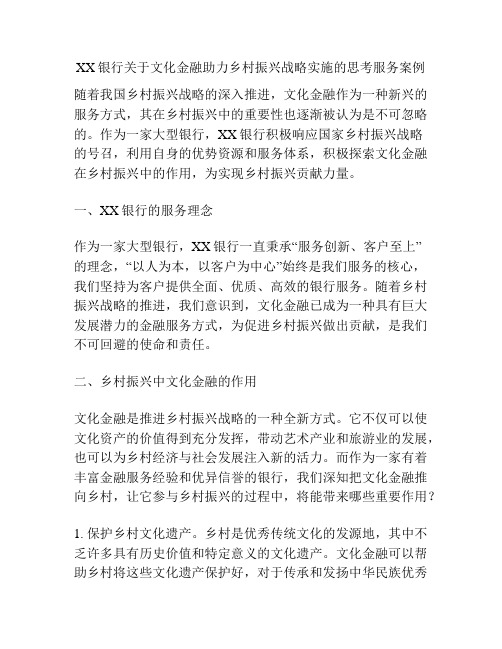
XX银行关于文化金融助力乡村振兴战略实施的思考服务案例随着我国乡村振兴战略的深入推进,文化金融作为一种新兴的服务方式,其在乡村振兴中的重要性也逐渐被认为是不可忽略的。
作为一家大型银行,XX银行积极响应国家乡村振兴战略的号召,利用自身的优势资源和服务体系,积极探索文化金融在乡村振兴中的作用,为实现乡村振兴贡献力量。
一、XX银行的服务理念作为一家大型银行,XX银行一直秉承“服务创新、客户至上”的理念,“以人为本,以客户为中心”始终是我们服务的核心,我们坚持为客户提供全面、优质、高效的银行服务。
随着乡村振兴战略的推进,我们意识到,文化金融已成为一种具有巨大发展潜力的金融服务方式,为促进乡村振兴做出贡献,是我们不可回避的使命和责任。
二、乡村振兴中文化金融的作用文化金融是推进乡村振兴战略的一种全新方式。
它不仅可以使文化资产的价值得到充分发挥,带动艺术产业和旅游业的发展,也可以为乡村经济与社会发展注入新的活力。
而作为一家有着丰富金融服务经验和优异信誉的银行,我们深知把文化金融推向乡村,让它参与乡村振兴的过程中,将能带来哪些重要作用?1. 保护乡村文化遗产。
乡村是优秀传统文化的发源地,其中不乏许多具有历史价值和特定意义的文化遗产。
文化金融可以帮助乡村将这些文化遗产保护好,对于传承和发扬中华民族优秀文化传统具有重要意义。
2. 激活文化产业。
文化金融可以帮助乡村将文化资源转化成商业资源,促进文化产业的发展,为乡村经济注入新的活力。
3. 带动旅游业的发展。
文化和旅游业有着密不可分的关系,文化金融可以通过各种手段支持乡村旅游业的发展,增强乡村旅游的吸引力。
三、XX银行文化金融服务案例1. 建设乡村文化公园文化公园是一种集文化体验、旅游、休闲等多重功能于一体的新型公园,旨在满足人们对于美好生活的追求。
XX银行将通过各种途径挖掘乡村文化资源,合作建设乡村文化公园,通过提供旅游、娱乐、体验等服务,为乡村振兴注入新的生命力。
公司战略案例(3篇)

第1篇一、背景介绍华为技术有限公司,成立于1987年,是中国领先的信息与通信技术(ICT)解决方案提供商。
自成立以来,华为一直致力于为全球客户提供优质的ICT产品和服务,包括通信网络、IT、智能终端和云服务等领域。
随着全球信息化进程的加速,华为逐步意识到全球化布局的重要性,并开始实施一系列战略举措以拓展国际市场。
二、战略目标华为的全球化战略目标是成为全球领先的ICT解决方案提供商,具体包括:1. 提升品牌影响力,使华为成为全球知名品牌。
2. 拓展国际市场份额,实现收入持续增长。
3. 建立全球化的研发体系,提升创新能力。
4. 培养国际化人才,提高企业竞争力。
三、战略举措1. 市场多元化华为通过实施市场多元化战略,积极拓展全球市场。
具体措施如下:(1)进入新兴市场:华为针对新兴市场的特点,提供定制化的解决方案,满足当地客户的需求。
例如,在非洲市场,华为针对当地网络覆盖不足的问题,推出低成本、高性能的网络解决方案。
(2)拓展发达国家市场:华为通过加大研发投入,提升产品品质,逐步进入发达国家市场。
例如,华为在全球范围内开展市场营销活动,提高品牌知名度。
(3)深化与合作伙伴关系:华为与全球范围内的运营商、设备制造商、软件开发商等建立战略合作关系,共同开拓市场。
2. 产品创新华为高度重视产品创新,通过以下措施提升产品竞争力:(1)加大研发投入:华为每年将销售收入的10%以上投入研发,持续提升技术创新能力。
(2)引进国际化人才:华为在全球范围内招聘优秀人才,引进国际先进技术和管理经验。
(3)构建全球化研发体系:华为在全球设立了多个研发中心,形成全球化研发体系,缩短产品研发周期。
3. 品牌建设华为通过以下措施提升品牌影响力:(1)参加国际展会:华为积极参加国际展会,展示企业实力和产品创新。
(2)赞助国际体育赛事:华为赞助国际体育赛事,提升品牌知名度和美誉度。
(3)开展公益慈善活动:华为关注社会责任,积极参与公益慈善活动,树立良好的企业形象。
公共部门战略案例
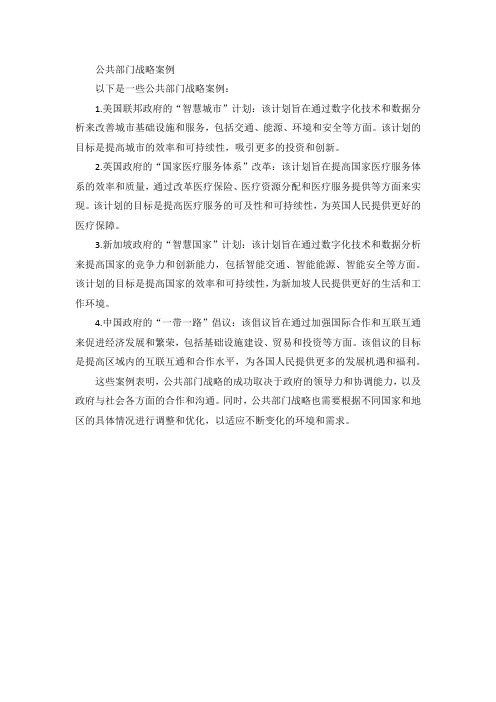
公共部门战略案例
以下是一些公共部门战略案例:
1.美国联邦政府的“智慧城市”计划:该计划旨在通过数字化技术和数据分析来改善城市基础设施和服务,包括交通、能源、环境和安全等方面。
该计划的目标是提高城市的效率和可持续性,吸引更多的投资和创新。
2.英国政府的“国家医疗服务体系”改革:该计划旨在提高国家医疗服务体系的效率和质量,通过改革医疗保险、医疗资源分配和医疗服务提供等方面来实现。
该计划的目标是提高医疗服务的可及性和可持续性,为英国人民提供更好的医疗保障。
3.新加坡政府的“智慧国家”计划:该计划旨在通过数字化技术和数据分析来提高国家的竞争力和创新能力,包括智能交通、智能能源、智能安全等方面。
该计划的目标是提高国家的效率和可持续性,为新加坡人民提供更好的生活和工作环境。
4.中国政府的“一带一路”倡议:该倡议旨在通过加强国际合作和互联互通来促进经济发展和繁荣,包括基础设施建设、贸易和投资等方面。
该倡议的目标是提高区域内的互联互通和合作水平,为各国人民提供更多的发展机遇和福利。
这些案例表明,公共部门战略的成功取决于政府的领导力和协调能力,以及政府与社会各方面的合作和沟通。
同时,公共部门战略也需要根据不同国家和地区的具体情况进行调整和优化,以适应不断变化的环境和需求。
战略案例分析:携程网1

优势分析
• • 优势六,UGC在旅游网站的运用。 UGC,全称为Users Generate Content,也就是用户生成内容的意思。实际上消 费者也在分享这样一个信息,旅游者就成了积极主动的一个信息的创造者。第 二步就是让消费者通过旅游资讯的人,了解消息,最后能够转化为产品。携程 网通过网上社区,积累知识以后,可以提供相应的旅行服务包括使业务更加多 元化,另外通过线上线下的服务,共同推广这个产品。携程每个产品的开发, 并不是简单地说外面需要什么就开发什么,每一个产品的开发都会按照网友在 网上的要求,通过BBS、通过游记、通过不同的途径,不断地开发产品,保证携 程不断创新。携程网的网络评价系统,在“酒店点评”方面,已经有了23万回 复。携程网的评价系统,消费者一定要通过携程预定才能写这个评语,这大大 不排除灌水和使坏的行为,相对来说质量明显有了提高。通过酒店点评,客户 能得到真实、全面、及时的消息的反馈。这个后来的消费者对酒店业务的预定 提供了极大的帮助。据统计,有三分之一的顾客会通过酒店点评来改变选择哪 结构 季琦握有跟梁建章、沈南鹏相差无几的股份。三人所占比 例分别是5.2%、6.3%、和7.3%。“如果没有摆平股权,最后 携程也不会有这么好的发展。”有了该公司产权布局,大家股 份悬殊无几,这样企业才会不断做大。这就是牛根生所谓的“ 财聚人散,财散人聚”。 • 良好的公司治理结构是企业战略实施的保证,否则企业无 法产生凝聚力,内部斗争不断,战略会演变成权力斗争的武器 或者妥协物。这就是所谓的权力学派战略。
1酒店预订代理费基本上是从目的地酒店的盈利折扣返还中获取的2机票预订代理费从顾客的订票费中获取的等于顾客订票费与航空公司出票价格的差价3自助游中的酒店机票预订代理费以及保险代理费其收入的途径也是采用了盈利折扣返还和差价两种方式
战略目标案例
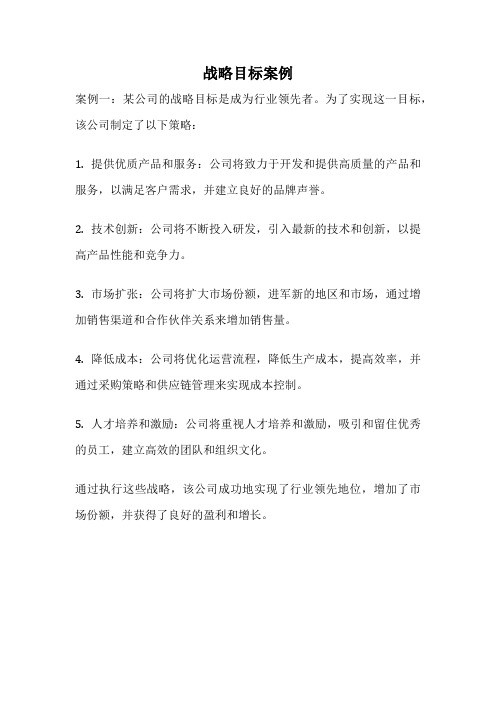
战略目标案例
案例一:某公司的战略目标是成为行业领先者。
为了实现这一目标,该公司制定了以下策略:
1. 提供优质产品和服务:公司将致力于开发和提供高质量的产品和服务,以满足客户需求,并建立良好的品牌声誉。
2. 技术创新:公司将不断投入研发,引入最新的技术和创新,以提高产品性能和竞争力。
3. 市场扩张:公司将扩大市场份额,进军新的地区和市场,通过增加销售渠道和合作伙伴关系来增加销售量。
4. 降低成本:公司将优化运营流程,降低生产成本,提高效率,并通过采购策略和供应链管理来实现成本控制。
5. 人才培养和激励:公司将重视人才培养和激励,吸引和留住优秀的员工,建立高效的团队和组织文化。
通过执行这些战略,该公司成功地实现了行业领先地位,增加了市场份额,并获得了良好的盈利和增长。
宝洁品牌多元化战略(案例)
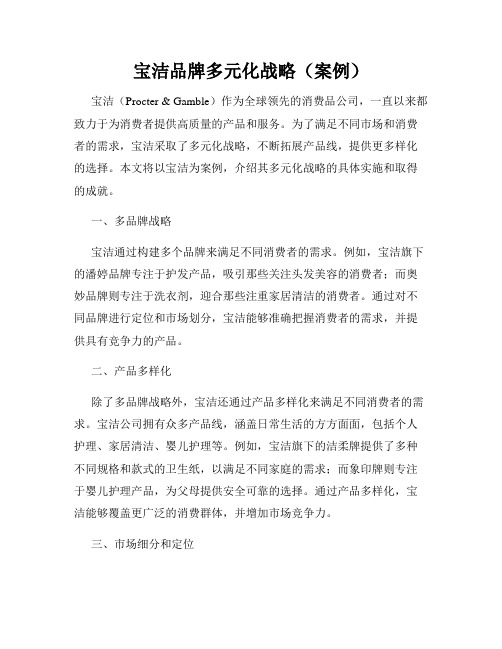
宝洁品牌多元化战略(案例)宝洁(Procter & Gamble)作为全球领先的消费品公司,一直以来都致力于为消费者提供高质量的产品和服务。
为了满足不同市场和消费者的需求,宝洁采取了多元化战略,不断拓展产品线,提供更多样化的选择。
本文将以宝洁为案例,介绍其多元化战略的具体实施和取得的成就。
一、多品牌战略宝洁通过构建多个品牌来满足不同消费者的需求。
例如,宝洁旗下的潘婷品牌专注于护发产品,吸引那些关注头发美容的消费者;而奥妙品牌则专注于洗衣剂,迎合那些注重家居清洁的消费者。
通过对不同品牌进行定位和市场划分,宝洁能够准确把握消费者的需求,并提供具有竞争力的产品。
二、产品多样化除了多品牌战略外,宝洁还通过产品多样化来满足不同消费者的需求。
宝洁公司拥有众多产品线,涵盖日常生活的方方面面,包括个人护理、家居清洁、婴儿护理等。
例如,宝洁旗下的洁柔牌提供了多种不同规格和款式的卫生纸,以满足不同家庭的需求;而象印牌则专注于婴儿护理产品,为父母提供安全可靠的选择。
通过产品多样化,宝洁能够覆盖更广泛的消费群体,并增加市场竞争力。
三、市场细分和定位宝洁通过市场细分和定位策略,将产品和服务针对性地推向目标消费者。
宝洁公司根据市场需求和消费者特点,将其产品分为不同的系列,并在不同的市场中进行定位。
比如,在发达国家,宝洁把重点放在高端市场,通过优质的产品和服务争取高收入消费者的青睐;而在发展中国家,宝洁则注重中低端市场,通过价格优势和便捷的渠道拓展消费者群体。
四、品牌合作与收购宝洁通过品牌合作和收购的方式扩大品牌影响力和市场份额。
宝洁与其他知名品牌展开合作,共同推出联名产品,在产品上注入双方的优势,实现优势互补。
同时,宝洁还通过收购其他公司来快速扩大自身在市场上的影响力。
例如,宝洁在2014年收购了杰威尔(Duracell),进一步强化了其在电池市场的地位。
多元化战略使宝洁公司在全球范围内取得了巨大的成功。
通过多品牌战略,宝洁在不同产品领域建立了强大的市场地位,并获得了广泛的认可和信任。
服务国家重大战略和区域经济社会发展的典型案例

服务国家重大战略和区域经济社会发展的典型案例标题:服务国家重大战略和区域经济社会发展的典型案例一、引言在当前发展的大背景下,服务国家重大战略和推动区域经济社会发展已成为各行各业共同关注的焦点。
在此背景下,我们将深入探讨一些典型案例,以展现其对国家重大战略和区域经济社会发展所做出的重大贡献。
二、典型案例分析1. XXX公司的可持续发展模式作为一个典型的专注于服务国家重大战略和区域经济社会发展的企业,XXX公司一直致力于可持续发展模式的推进。
通过不断创新,他们在环保、科技、就业等方面取得了显著成绩,为国家经济社会发展贡献了力量。
2. XXX城市的智慧化建设在推动区域经济社会发展方面,XXX城市可谓是典型中的典型。
他们通过智慧化建设,在城市规划、交通、医疗等方面的创新举措,成为了国家重大战略的重要推动力量,同时也为区域经济社会发展注入了强大的动力。
3. XXX省的产业升级与转型作为一个典型的区域经济社会发展的案例,XXX省在产业升级和转型中展现出了巨大的潜力。
他们通过优化产业结构、加速科技创新等举措,为全国的战略发展作出了突出的贡献。
三、个人观点与总结从上述典型案例中我们可以看出,服务国家重大战略和区域经济社会发展的典型案例在不同领域都取得了丰富的成绩。
他们不仅在经济发展上作出了贡献,更是对国家整体战略方向的有力支持。
服务国家重大战略和区域经济社会发展的典型案例具有不可替代的重要作用,我们应当更加重视并学习他们的成功经验,不断推动国家和地方发展迈上新的台阶。
四、结语通过对上述典型案例的分析以及个人观点的表达,我们对服务国家重大战略和区域经济社会发展的典型案例有了更深入的了解。
未来,我们期待更多的行业和地区能够成为典型案例,为国家和地方的发展注入更多动力。
以典型案例为切入点,我们可以看到在服务国家重大战略和推动区域经济社会发展的过程中,不同行业、企业和地区都发挥着重要的作用。
他们在可持续发展、智慧化建设、产业升级和转型等方面展现出了创新和成就,为国家和地方的发展贡献了积极力量。
医疗行业战略管理经典案例

医疗行业战略管理经典案例本文将介绍医疗行业中的两个经典案例,这些案例展示了成功的战略管理实践。
通过深入研究这些案例,我们可以从中汲取经验,为我们日后的决策提供参考。
案例一:百健医疗集团百健医疗集团是一家在医疗行业取得巨大成功的公司。
他们的战略管理实践着重于提供质量卓越的医疗服务,并成为顾客首选的医疗机构。
百健医疗集团的成功战略可以总结如下:1. 专注于质量:百健医疗集团将质量作为核心价值,通过不断提升医疗服务水平来满足患者的需求和期望。
他们建立了严格的质量管理体系,并持续关注患者满意度的指标。
2. 投资创新技术:百健医疗集团积极投资于创新技术,以提升医疗服务的效率和质量。
他们引入了先进的医疗设备和信息化管理系统,提高了医疗流程的效率和准确性。
3. 构建专家团队:百健医疗集团重视人才培养和团队建设,吸引并培养了一支专业的医疗团队。
他们注重团队协作和知识共享,提高了医疗服务的综合水平。
通过以上战略管理实践,百健医疗集团在医疗行业中取得了显著的成绩。
案例二:康复之路康复中心康复之路康复中心是一家在康复医疗领域取得成功的机构。
他们的战略管理实践着眼于提供全面的、个性化的康复服务,满足患者的康复需求。
康复之路康复中心的成功战略可以总结如下:1. 个性化康复方案:康复之路康复中心针对每个患者的康复需求定制个性化的康复方案。
他们通过全面评估和多学科团队合作,确保康复方案能够最大程度地满足患者的需求。
2. 提供综合服务:康复之路康复中心提供全面的康复服务,包括物理治疗、职业治疗、言语治疗等。
他们通过多种康复手段和方法,为患者提供全方位的康复支持。
3. 关注患者体验:康复之路康复中心非常注重患者的体验。
他们建立了良好的沟通机制,保持与患者的互动,及时解决患者的问题和关切。
他们还提供温馨的康复环境和个性化的服务,增强患者对康复中心的信任和满意度。
通过以上战略管理实践,康复之路康复中心赢得了患者的信赖,并在康复医疗领域取得了良好的口碑。
企业战略管理案例分析及答案路虎
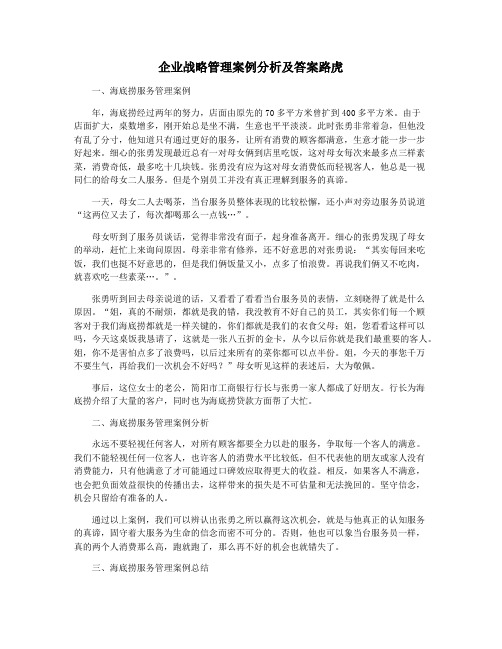
企业战略管理案例分析及答案路虎一、海底捞服务管理案例年,海底捞经过两年的努力,店面由原先的70多平方米曾扩到400多平方米。
由于店面扩大,桌数增多,刚开始总是坐不满,生意也平平淡淡。
此时张勇非常着急,但他没有乱了分寸,他知道只有通过更好的服务,让所有消费的顾客都满意,生意才能一步一步好起来。
细心的张勇发现最近总有一对母女俩到店里吃饭,这对母女每次来最多点三样素菜,消费奇低,最多吃十几块钱。
张勇没有应为这对母女消费低而轻视客人,他总是一视同仁的给母女二人服务。
但是个别员工并没有真正理解到服务的真谛。
一天,母女二人去喝茶,当台服务员整体表现的比较松懈,还小声对旁边服务员说道“这两位又去了,每次都喝那么一点钱…”。
母女听到了服务员谈话,觉得非常没有面子,起身准备离开。
细心的张勇发现了母女的举动,赶忙上来询问原因。
母亲非常有修养,还不好意思的对张勇说:“其实每回来吃饭,我们也挺不好意思的,但是我们俩饭量又小,点多了怕浪费。
再说我们俩又不吃肉,就喜欢吃一些素菜…。
”。
张勇听到回去母亲说道的话,又看看了看看当台服务员的表情,立刻晓得了就是什么原因。
“姐,真的不耐烦,都就是我的错,我没教育不好自己的员工,其实你们每一个顾客对于我们海底捞都就是一样关键的,你们都就是我们的衣食父母;姐,您看看这样可以吗,今天这桌饭我恳请了,这就是一张八五折的金卡,从今以后你就是我们最重要的客人。
姐,你不是害怕点多了浪费吗,以后过来所有的菜你都可以点半份。
姐,今天的事您千万不要生气,再给我们一次机会不好吗?”母女听见这样的表述后,大为敬佩。
事后,这位女士的老公,简阳市工商银行行长与张勇一家人都成了好朋友。
行长为海底捞介绍了大量的客户,同时也为海底捞贷款方面帮了大忙。
二、海底捞服务管理案例分析永远不要轻视任何客人,对所有顾客都要全力以赴的服务,争取每一个客人的满意。
我们不能轻视任何一位客人,也许客人的消费水平比较低,但不代表他的朋友或家人没有消费能力,只有他满意了才可能通过口碑效应取得更大的收益。
差异化战略案例

吴志航09一、产品差异化海底捞在继承川、渝餐饮文化原有的“麻、辣、鲜、香、嫩、脆”等特色的基础上,不断创新,以独特、纯正、鲜美的口味和营养健康的菜品,赢得了顾客的一致推崇并在众多的消费者心目中留下了“好火锅自己会说话”的良好口碑。
海底捞始终坚持“绿色,无公害,一次性”的选料和底料原则,严把原料关,配料关,十三年来历经市场和顾客的检验,成功的打造出信誉度高,颇具四川火锅特色,融汇巴蜀餐饮文化“蜀地,蜀风”浓郁的优质火锅品牌。
海底捞的火锅有10多种锅底,口味选择丰富。
还有就是它的调料,除了一般的麻酱和油碟外还有海底捞自制特色调料,根据个性喜欢选择辣或者不辣,如今已改成自助式,20多种原材料任由搭配。
在新菜品开发方面,海底捞打造了三大系列的菜品:健美食品系列(能预防肥胖以及胆固醇升高等城市病、现代病,保持人体生态平衡的食品系列)绿色食品系列(即安全无害、无污染,绝对新鲜的食品)营养食品系列(补充人体所缺乏的各种微量元素,具有增强体力和开发智力的食品)在食品安全和卫生方面,海底捞也制定了标准化的工程体系:产品菜品安全保证每种菜品、底料的生产制作符合国家规定标准,配有权威部门的合格检验报告书。
此外,各店还建立菜品24小时留样制度,以备出现食品卫生安全问题时追溯和查验。
菜品制作标准化工程。
制作后堂所有菜品的《技术标准操作手册》制作技术标准化操作示范光盘。
后堂操作透明化工程,即将后堂卫生,操作全过程通过视频在顾客就餐大厅展示。
海底捞在保证产品安全卫生的同时,将后堂操作透明化,使顾客产生信赖感,产品形成品牌效应,达到了更好的差异化效果。
“美其食必先美其器”,如今的消费者去就餐并非满足简单的吃饱,而更多的在追求消费体验,而环境正是满足消费者消费体验的最明显的体现。
从中式餐饮环境的发展趋势来看,时尚化、西餐化成为一种发展潮流。
这种餐饮时尚化很大程度满足了年轻顾客对就餐环境的需要和情感依托,而西餐代表着精致、干净整洁。
战略管理案例谷歌的多元化战略案例

战略管理案例谷歌的多元化战略案例战略管理案例:谷歌的多元化战略谷歌(Google)作为全球最大的互联网搜索引擎公司之一,一直以来都以其独特的战略管理能力著称。
本文将重点讨论谷歌的多元化战略案例,并分析其成功的原因。
一、引言谷歌作为一家科技巨头,一直以来都非常注重战略的制定和管理。
在市场的日益竞争激烈化的情况下,谷歌通过多元化战略的采取,不仅巩固了其搜索引擎的市场地位,还进一步拓宽了业务领域。
二、多元化战略的理论背景多元化战略是企业在寻找新的增长点和市场机会时的一种战略选择。
采取多元化战略有助于企业减少市场风险,增加收入来源,提升核心竞争力等。
而谷歌正是以此为目标,通过不断拓展业务领域实现多元化发展。
三、谷歌的多元化战略案例1. 谷歌搜索引擎谷歌的搜索引擎一直是其最主要的业务,也是其最成功的产品之一。
通过不断提升搜索算法和用户体验,谷歌在全球范围内赢得了广大用户的喜爱和信赖。
同时,谷歌搜索引擎还提供了广告服务,进一步实现了盈利增长。
2. 谷歌广告业务为了进一步扩大盈利来源,谷歌通过收购AdWords和DoubleClick 等公司,建立了庞大的广告平台。
谷歌广告业务成为其最重要的收入来源之一,每年贡献了数十亿美元的收入。
通过广告业务,谷歌不仅为企业提供了广告推广平台,也使得谷歌能够获得更多的用户数据,进一步改善其搜索引擎算法。
3. 谷歌移动操作系统Android为了在移动领域抢占先机,谷歌推出了开放源代码的移动操作系统Android。
Android的开放性吸引了众多手机厂商和应用开发者,使得其成为全球最大的移动操作系统之一。
通过Android操作系统,谷歌有效地抢占了移动搜索和广告市场,进一步提升了公司的盈利能力和市场地位。
4. 谷歌云计算服务为了与亚马逊(Amazon)和微软(Microsoft)等云计算巨头竞争,谷歌推出了其云计算服务Google Cloud Platform。
通过提供云计算基础设施和服务,谷歌帮助企业存储和处理大量数据,并提供机器学习和人工智能等先进技术支持。
服务营销策略的案例
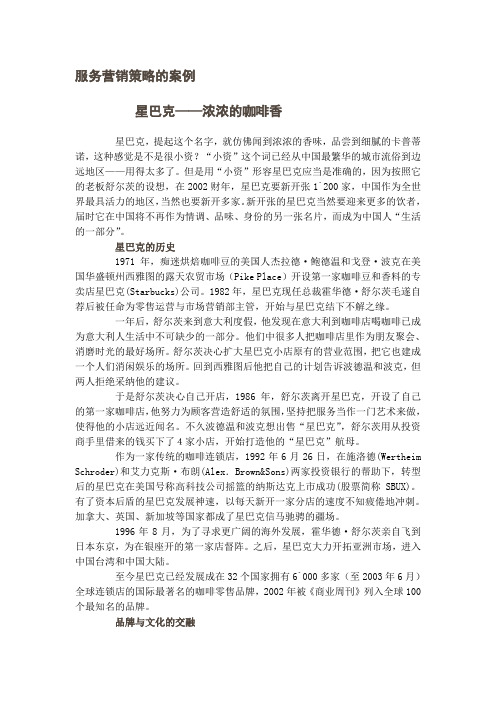
服务营销策略的案例星巴克——浓浓的咖啡香星巴克,提起这个名字,就仿佛闻到浓浓的香味,品尝到细腻的卡普蒂诺,这种感觉是不是很小资?“小资”这个词已经从中国最繁华的城市流俗到边远地区——用得太多了。
但是用“小资”形容星巴克应当是准确的,因为按照它的老板舒尔茨的设想,在2002财年,星巴克要新开张1`200家,中国作为全世界最具活力的地区,当然也要新开多家。
新开张的星巴克当然要迎来更多的饮者,届时它在中国将不再作为情调、品味、身份的另一张名片,而成为中国人“生活的一部分”。
星巴克的历史1971年,痴迷烘焙咖啡豆的美国人杰拉德·鲍德温和戈登·波克在美国华盛顿州西雅图的露天农贸市场(Pike Place)开设第一家咖啡豆和香料的专卖店星巴克(Starbucks)公司。
1982年,星巴克现任总裁霍华德·舒尔茨毛遂自荐后被任命为零售运营与市场营销部主管,开始与星巴克结下不解之缘。
一年后,舒尔茨来到意大利度假,他发现在意大利到咖啡店喝咖啡已成为意大利人生活中不可缺少的一部分。
他们中很多人把咖啡店里作为朋友聚会、消磨时光的最好场所。
舒尔茨决心扩大星巴克小店原有的营业范围,把它也建成一个人们消闲娱乐的场所。
回到西雅图后他把自己的计划告诉波德温和波克,但两人拒绝采纳他的建议。
于是舒尔茨决心自己开店,1986年,舒尔茨离开星巴克,开设了自己的第一家咖啡店,他努力为顾客营造舒适的氛围,坚持把服务当作一门艺术来做,使得他的小店远近闻名。
不久波德温和波克想出售“星巴克”,舒尔茨用从投资商手里借来的钱买下了4家小店,开始打造他的“星巴克”航母。
作为一家传统的咖啡连锁店,1992年6月26日,在施洛德(Wertheim Schroder)和艾力克斯·布朗(Alex.Brown&Sons)两家投资银行的帮助下,转型后的星巴克在美国号称高科技公司摇篮的纳斯达克上市成功(股票简称SBUX)。
服务管理运作战略的四大经典案例
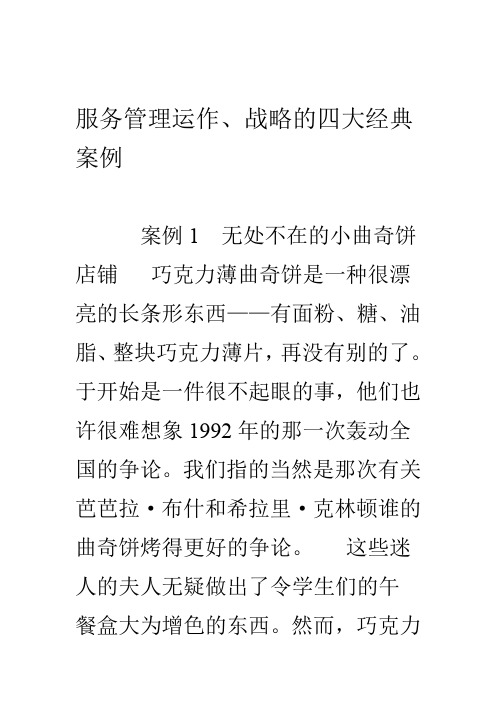
服务管理运作、战略的四大经典案例案例1 无处不在的小曲奇饼店铺巧克力薄曲奇饼是一种很漂亮的长条形东西——有面粉、糖、油脂、整块巧克力薄片,再没有别的了。
于开始是一件很不起眼的事,他们也许很难想象1992年的那一次轰动全国的争论。
我们指的当然是那次有关芭芭拉·布什和希拉里·克林顿谁的曲奇饼烤得更好的争论。
这些迷人的夫人无疑做出了令学生们的午餐盒大为增色的东西。
然而,巧克力曲奇饼上的重大革命却使她们的努力大为失色。
这场革命是一个年轻女人德比·菲娅·菲尔兹发起的,她烤制巧克力薄饼的历史可以追溯到她幼时为家人和朋友烤饼的年代。
菲尔兹夫人1977年在加利福尼亚和夏威夷北部的其他城市建立了分店。
在这个发展过程中,她始终亲自参与其中并保持控制,她的成功是因为她的曲奇饼的质18/ 1量,也因为她和顾客的良好关系以及她天生的经营头脑。
当她在这个国家的其他地方开始发展时,显然她希望的那种亲自参与日常操作和控制的传统方法在这种广泛生产的情况下已不适用了。
当时,她觉得对于她来说,赋予某种特许权,例如授权给别人并相应减少在质量和服务上的控制是不可接受的,因此,这个挑战就变成如何建立一个适合菲尔兹夫人要求的组织和运营结构。
菲尔兹先生加入了。
兰迪·菲尔兹是一个经济学家,菲尔兹夫妇一起发展了他们的事业。
据一位公司发言人说,在1993年2月,在国内就已建立了348家菲尔兹夫人曲奇饼店,另外还有36家国际曲奇饼店。
在当时苛刻的经济环境下,还有34家特许经销店。
菲尔兹夫妇通过发展一种扁平的组织结构和有效的信息系统解决了保持对广泛的业务进行直接控制的问题。
组织结构每家饼店只有一名管理人员,即饼店经理。
一个地区经理(DSM)监督几个饼店经理18/ 2并向区域业务主任(RDO)报告。
区域业务主任们向两个总部业务主任报告,总部业务主任再轮流向菲尔兹夫人报告。
区域主任和地区经理为商店制定营销决策,而在犹他州帕克城的总部里,总会计师管理财务。
酒店行业中的战略合作的成功案例

酒店行业中的战略合作的成功案例酒店行业作为服务性行业的代表之一,其发展与市场竞争日益激烈。
在这个竞争激烈的环境下,战略合作成为酒店企业实现持续发展的重要手段之一。
本文将通过分析酒店行业中的战略合作的成功案例,探讨战略合作对于酒店企业的重要性以及如何实现成功合作。
一、合作案例:酒店与旅游公司的合作酒店与旅游公司的合作是一种常见的战略合作方式。
通过与旅游公司的合作,酒店可以获得更多的客源,提高入住率和收益。
同时,旅游公司可以通过与酒店合作,为客户提供更好的住宿体验,增加旅游产品的吸引力。
在中国,如携程与酒店集团的合作就是一个成功的案例。
携程作为中国最大的在线旅游平台,与各大酒店集团建立了长期合作关系。
通过携程平台的推广和资源整合,酒店集团可以获得更多的客户流量和曝光度,提高酒店的知名度和市场份额。
同时,携程也能够通过与酒店集团的合作,提供更多的酒店选择给消费者,提高用户的满意度和忠诚度。
二、战略合作对酒店企业的重要性1. 扩大市场份额:通过与其他企业的合作,酒店可以共享对方的客户资源,扩大市场份额。
合作伙伴的客户可以通过合作企业的推荐和介绍,选择入住酒店,从而提高酒店的入住率和收益。
2. 提升品牌形象:与知名企业合作,可以提升酒店的品牌形象和知名度。
合作伙伴的品牌影响力可以为酒店带来更多的曝光度和口碑推广,增加消费者对酒店的信任和好感。
3. 提供综合服务:通过与其他企业的合作,酒店可以提供更多的综合服务,满足客户多样化的需求。
例如,与旅游公司合作可以提供旅游景点门票、导游服务等,与餐饮企业合作可以提供更多的餐饮选择等。
三、实现成功合作的关键要素1. 互利共赢:战略合作的双方应该在合作中实现互利共赢的目标。
合作伙伴之间应该有共同的利益和目标,通过合作可以实现双方的利益最大化。
2. 互补资源:合作伙伴之间应该具备互补的资源和能力。
双方的资源可以相互补充,形成合作的优势,提高合作的效果。
3. 长期合作:战略合作应该是长期的、稳定的合作关系。
战略金字塔案例

战略金字塔案例一、愿景层:成为街头巷尾最酷的休闲小站。
想象一下,在每个城市的大街小巷,只要人们想找个地方放松一下,喝杯美味的饮品,第一个想到的就是我们的奶茶店。
我们的店就像一个小小的快乐源泉,不管是上班族忙里偷闲,还是小情侣甜蜜约会,或者是学生党课后闲聊,都觉得我们这儿是最棒的去处。
二、使命层:用奶茶传递幸福滋味和独特体验。
每一杯奶茶都是我们传递幸福的使者。
我们的使命就是把那些精心挑选的茶叶、新鲜的牛奶、香甜的水果混合在一起,调出一杯杯能让人喝了就忍不住露出笑容的奶茶。
而且,不只是奶茶的味道要好,从顾客走进店里的那一刻起,看到温馨的装修,闻到奶茶的香气,听到轻柔的音乐,再到店员热情的服务,整个过程都是一种独特的体验。
就像一场小小的幸福之旅,而我们是这个旅程的导游。
三、业务层战略。
1. 产品战略:口味创新与经典并存。
一方面,我们要不断推出新奇的口味。
比如说,在夏天的时候推出一款“西瓜薄荷冰奶茶”,西瓜的清甜加上薄荷的清凉,再混合着奶茶的醇厚,那口感就像在嘴里开了一场夏日派对。
另一方面,像珍珠奶茶这种经典款,我们也要把它做到极致。
珍珠要煮得Q弹软糯,奶茶的茶味和奶味比例要恰到好处,让那些喜欢经典口味的顾客每次喝都觉得是一种享受。
2. 营销战略:线上线下齐发力。
在线上,我们要成为社交媒体的网红店。
找一些美食博主来试喝我们的奶茶,然后在抖音、小红书这些平台上分享。
我们自己也要经营好官方账号,定期发布一些有趣的视频,比如制作奶茶的过程,或者是一些关于奶茶搭配小点心的创意。
在线下,在店门口放一个大大的招牌,上面写着当天的特色奶茶。
然后在周边的写字楼、学校、社区发放优惠券,吸引更多的人来尝试。
还可以和附近的商家合作,比如和电影院合作,推出看电影送奶茶的活动。
3. 服务战略:贴心周到超预期。
店员要经过严格的培训,对每一个顾客都要笑脸相迎。
如果顾客在纠结喝什么,店员要能根据顾客的喜好给出专业的建议。
而且,我们还可以提供一些额外的服务,比如如果顾客在店里喝奶茶,我们可以提供免费的小饼干;如果顾客点的奶茶比较多,我们可以免费帮忙送到附近的地方。
- 1、下载文档前请自行甄别文档内容的完整性,平台不提供额外的编辑、内容补充、找答案等附加服务。
- 2、"仅部分预览"的文档,不可在线预览部分如存在完整性等问题,可反馈申请退款(可完整预览的文档不适用该条件!)。
- 3、如文档侵犯您的权益,请联系客服反馈,我们会尽快为您处理(人工客服工作时间:9:00-18:30)。
案例5-1America West AirlinesAmerica West Airlines was established in phoenix as an employee-owned organization and began by serving 10 cities in the southwestern United States with a fleet of new Boeing 737 aircraft. This neophyte company showed remarkable daring by entering an arena where the majors, America Airlines and Delta Air Lines, already were firmly entrenched and where Southwest Airlines was digging in. Even more daring-some would say foolhardy-was the timing: deregulation was threatening to swallow up small airlines faster than they could refuel their planes.America West, however, came into the game prepared with a skilled and creative management team, well-trained support personnel, and an effective inside pitch. Obviously, the fledgling company did not have the resources to provide the nationwide, much less the worldwide, coverage that American and Delta provided. Its smaller region, however, allowed it to do something the majors could not: America West established a major hub in Phoenix and offered more flights per day at lower cost between its cities than the two larger competitors could. In many cases, America West offered direct routing and, consequently, relatively short flight times between destinations. “Burdened”with serving everywhere from Tallahassee to Seattle, American and Delta were able to schedule flights between America West destinations, but with longer layovers and at premium prices because they were major carriers. For example, consider travel from Austin, Texas, to Los Angeles. America West has four flights scheduled each day, with each taking approximately 4.5 hours and requiring one layover of 30 minutes in Phoenix, and its least expensive fare is $238. American Airlines offers eight flights each day, with each lasting at least 5 hours, but the traveler has a 60-minute layover in Dallas and spends $298 for American’s least expensive flight.When America West passengers have a layover, it is almost always at the Phoenix hub. (America West has a “sub-hub” in Las Vegas, where layovers usually are overnight, an appeal not lost on many travelers.) Consequently, America West’s “accommodations” at the Phoenix airport are as comfortable as one could hope for in a place that hosts such a larger number of people each day. The waiting areas arespacious, with banks of well-padded seats placed farther apart than in most airports. Television monitors are mounted in several places throughout the facility, and because the concessions are run by nationally known fast-food franchises, the traveler has ample reason to “feel at home.”Southwest Airlines presented a competitive challenge somewhat different from that of American and Delta. Southwest was serving the same general region as America West and also was offering frequent, low-cost flights with Boeing 737 aircraft. Thus, it would seem that these two airlines were meeting head to head and might be destined to “flight”-to-the-finish of one of them.Southwest established its hub at Love Field in Dallas, thereby offering its passengers easier access both to and from the city, which is especially attractive to commuters. (Landing at Love Field, does, however, present a problem for those who must make connections in the Dallas-Fort Worth International Terminal.) Southwest began as the “fun airline,”the one with attendants in hot pants and snappy commercials on television. Since then it has created a competitive challenge by offering its frequent, low-cost, no-frills service nationwide. It now has four fare rates including an occasional promotional fare, and there is no need to call at 1 AM “to see if fares have changed in the past ten hours.” Initially, reservations for flights could be made by phone, but they had to be paid for either through a travel agent or in person at the airport desk. Passengers now have the luxury of purchasing tickets electronically over the Internet or from Southwest’s version of ticketing “ATMs”located in many airports. There are no preassigned seats; seating is handled on a first-come, first-served basis according to a numbered boarding pass that is handed to the passenger at check-in time. One-board amenities usually are limited to free soft drinks, juice, and peanuts. Prepackaged cookies and crackers with cheese or peanut butter are available on long flights, and alcoholic beverages are available for a price. Except for short commuter flights, routing might involve several lengthy layovers.Thus far, America West has managed to meet Southwest’s challenge to some extent. Preassigned seating can be done by telephone, and, in contrast to Southwest’s ticketing policy, travel agents can ticket passengers using the SABRE reservation system. On-board amenities include complimentary copies of USA Today and TheWall Street Journal, and, on longer trips, an uncooked snack such as a sandwich, salad, cheese, fruit, and dessert.As the public air transport industry has matured, however, Southwest has set the “gold standard” for safety, efficiency, and satisfaction in the skies. Where Southwest leads in pricing, on-time arrivals, and “no frills” service, others still follow. Question:1. What generic competitive strategy has America West chosen to use in entering the air passenger market? What are the dangers of this strategy?2. Identify the service winners, qualifiers, and service losers in America West’s market.3. How has America West addressed the eight elements in its strategic service concept?美国西部航空公司美国西部航空公司建于菲尼克斯,是一个“职员所有”的企业,拥有一组波音737飞机,最初服务于美国西南部的10个城市。
